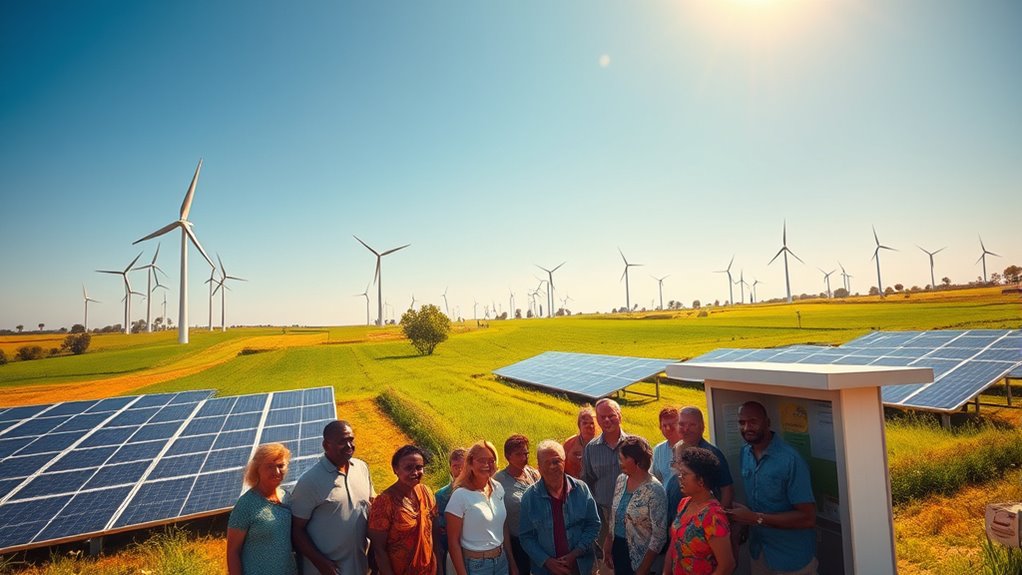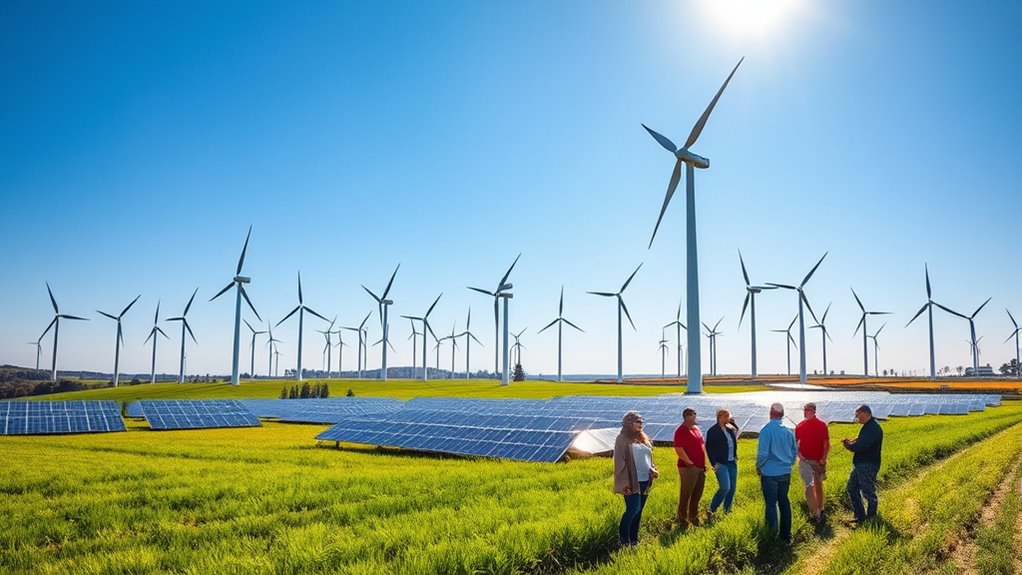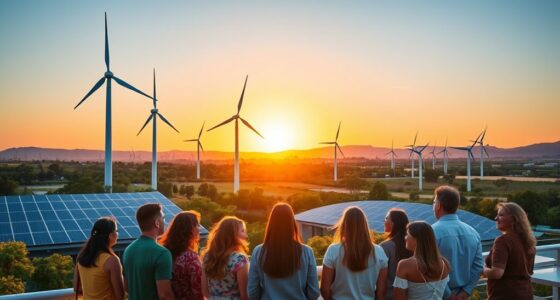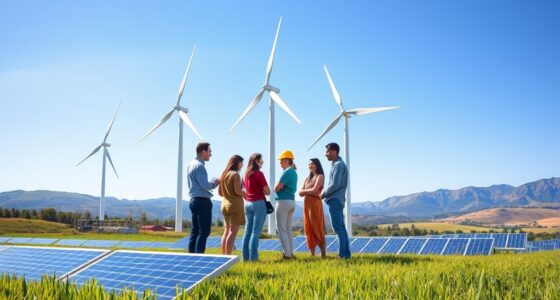Joining community-owned wind and solar projects lets you invest locally while saving money on energy bills. You’ll share in the profits and help create a more resilient, sustainable energy future for your neighborhood. These projects strengthen bonds, promote local growth, and reduce dependence on distant utility companies. Participation empowers you to make a positive environmental impact and enjoy long-term savings. Keep exploring how you can get involved and make a difference in your community’s energy journey.
Key Takeaways
- Community-owned projects foster local investment, giving residents a stake in renewable energy and boosting community pride.
- Joining these projects can lower energy costs and generate profits that stay within the local economy.
- Active community engagement ensures projects meet local needs, increasing satisfaction and trust.
- They enhance community resilience by reducing dependence on external energy sources and creating local jobs.
- Participating supports environmental goals, promotes social cohesion, and provides long-term financial and sustainability benefits.

Have you ever wondered how communities can take control of their energy future? One powerful way is through community-owned wind and solar projects. These initiatives allow residents to invest directly in renewable energy, giving you a sense of ownership and pride in the local power grid. Not only does this foster a stronger community connection, but it also brings tangible financial benefits. When your community invests in renewable energy, the profits generated from selling excess power stay within the community, often leading to lower energy costs for residents and local businesses. This means you can save money on your electricity bills, and the community can reinvest those savings into other local needs, such as schools or infrastructure. Plus, as renewable energy prices continue to drop, these projects become even more cost-effective, making them an attractive option for communities looking to cut expenses and promote sustainability simultaneously.
Community-owned renewable projects boost local savings and pride through shared energy benefits.
Community engagement plays an essential role in the success of these projects. When residents participate in the planning and decision-making processes, it creates a sense of shared responsibility and ensures that the projects meet local needs. Your involvement can range from attending public meetings to becoming an investor or volunteer. This active participation helps demystify renewable energy and builds trust between project developers and the community. As more people get involved, the project gains momentum and broader support, making it easier to secure funding and navigate regulatory hurdles. Community engagement also opens opportunities for educational outreach, helping residents understand the long-term benefits of renewable energy and encouraging sustainable habits. When everyone has a voice, the project reflects the community’s values and priorities, leading to higher levels of satisfaction and ongoing support.
Furthermore, community-owned projects cultivate local resilience. Instead of relying solely on distant utility companies, your community generates its own clean energy, reducing dependence on fossil fuels and the risks associated with energy supply disruptions. This local control can foster innovation and create jobs, as community members may be involved in installation, maintenance, and management. The sense of collective achievement and environmental stewardship strengthens social bonds and encourages ongoing participation. Incorporating high-efficiency project components can further maximize energy output and project longevity.
In essence, community-owned wind and solar projects are more than just energy solutions—they’re opportunities for economic growth, environmental stewardship, and social cohesion. When you participate, you’re not just investing in clean energy; you’re investing in your community’s future. These projects empower residents, foster community engagement, and deliver financial benefits that ripple through the local economy. If you’re looking for a way to make a positive impact, joining or supporting such initiatives could be one of the most rewarding decisions you make.
Frequently Asked Questions
How Do Community Projects Impact Local Energy Bills?
Community projects can substantially lower your energy bills by boosting energy independence and reducing reliance on external providers. When you participate in local solar or wind initiatives, the community benefits from shared costs and increased renewable energy production. This active community engagement helps stabilize prices and keeps more money in your local economy. Ultimately, you save money while supporting sustainable energy, creating a positive impact for everyone involved.
What Are the Initial Costs to Join a Project?
The initial costs to join a renewable project vary, but they typically include a membership fee or investment to support renewable financing. You’ll need to participate in community engagement efforts and contribute upfront funds, which help cover installation and setup costs. These investments often lead to long-term savings on energy bills and support local clean energy initiatives, making your involvement both financially and environmentally beneficial.
Are There Any Tax Incentives for Participating?
You’ll find that participating in community-owned wind and solar projects often comes with tax credits and other financial incentives. These benefits can reduce your overall costs and improve your return on investment. Many programs offer federal tax credits, like the Investment Tax Credit (ITC), and state or local incentives that make joining more affordable. Be sure to check your area’s specific programs to maximize the financial advantages of your participation.
How Is the Project’s Success Measured Over Time?
Think of a thriving garden, where growth signals success. You measure project performance over time through factors like energy output, financial stability, and environmental impact. Stakeholder engagement plays a vital role, as active participation indicates strong community support. Regular monitoring and transparent reporting help you track progress, ensuring the project remains sustainable and beneficial. By nurturing these elements, you can confidently assess how well your community-driven energy project is flourishing.
Can I Sell My Shares Back if I Move Away?
If you’re considering relocating, check the project’s relocation policies first. Usually, these policies outline whether you can do a share transfer if you move away. Some projects allow you to sell your shares back, while others may have restrictions. It’s important to review the specific agreement or contact the project administrators to understand your options for a share transfer or selling your shares if you relocate.
Conclusion
Joining a community-owned wind and solar project is like planting a seed that grows into a mighty tree, providing shade and nourishment for generations. It’s your chance to be part of a powerful movement that transforms the energy landscape and fuels a cleaner future. By stepping in, you’re not just a bystander—you’re the wind beneath its wings, helping the sun rise on sustainable change. Together, we can turn the tide toward a brighter, greener tomorrow.










